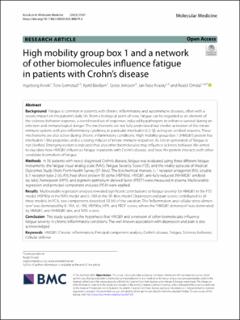| dc.contributor.author | Kvivik, Ingeborg | |
| dc.contributor.author | Grimstad, Tore Bjørn | |
| dc.contributor.author | Bårdsen, Kjetil | |
| dc.contributor.author | Jonsson, Grete | |
| dc.contributor.author | Kvaløy, Jan Terje | |
| dc.contributor.author | Omdal, Roald | |
| dc.date.accessioned | 2023-12-19T13:37:04Z | |
| dc.date.available | 2023-12-19T13:37:04Z | |
| dc.date.created | 2023-08-24T10:09:44Z | |
| dc.date.issued | 2023-06 | |
| dc.identifier.citation | Kvivik, I., Grimstad, T., Bårdsen, K., Jonsson, G., Kvaløy, J.T. & Omdal, R. (2023) High mobility group box 1 and a network of other biomolecules influence fatigue in patients with Crohn’s disease. Molecular medicine, 29 (1), 81 (2023) | en_US |
| dc.identifier.issn | 1076-1551 | |
| dc.identifier.uri | https://hdl.handle.net/11250/3108232 | |
| dc.description.abstract | Background
Fatigue is common in patients with chronic inflammatory and autoimmune diseases, often with a severe impact on the patient’s daily life. From a biological point of view, fatigue can be regarded as an element of the sickness behavior response, a coordinated set of responses induced by pathogens to enhance survival during an infection and immunological danger. The mechanisms are not fully understood but involve activation of the innate immune system, with pro-inflammatory cytokines, in particular interleukin (IL)-1β, acting on cerebral neurons. These mechanisms are also active during chronic inflammatory conditions. High mobility group box 1 (HMGB1) protein has interleukin-1 like properties and is a strong inducer of innate immune responses. Its role in generation of fatigue is not clarified. Emerging evidence indicates that also other biomolecules may influence sickness behavior. We aimed to elucidate how HMGB1 influences fatigue in patients with Crohn’s disease, and how the protein interacts with other candidate biomarkers of fatigue.
Methods
In 56 patients with newly diagnosed Crohn’s disease, fatigue was evaluated using three different fatigue instruments: the fatigue visual analog scale (fVAS), Fatigue Severity Scale (FSS), and the vitality subscale of Medical Outcomes Study Short-Form Health Survey (SF-36vs). The biochemical markers IL-1 receptor antagonist (RA), soluble IL-1 receptor type 2 (sIL-RII), heat shock protein 90 alpha (HSP90α), HMGB1, anti-fully reduced (fr)HMGB1 antibodies (abs), hemopexin (HPX), and pigment epithelium-derived factor (PEDF) were measured in plasma. Multivariable regression and principal component analyses (PCA) were applied.
Results
Multivariable regression analyses revealed significant contributions to fatigue severity for HMGB1 in the FSS model, HSP90α in the fVAS model and IL-1RA in the SF-36vs model. Depression and pain scores contributed to all three models. In PCA, two components described 53.3% of the variation. The “inflammation and cellular stress dimension” was dominated by IL-1RA, sIL-1RII, HSP90α, HPX, and PEDF scores, where the “HMGB1 dimension” was dominated by HMGB1, anti-frHMGB1 abs, and fVAS scores.
Conclusion
This study supports the hypothesis that HMGB1 and a network of other biomolecules influence fatigue severity in chronic inflammatory conditions. The well-known association with depression and pain is also acknowledged. | en_US |
| dc.language.iso | eng | en_US |
| dc.publisher | BioMed Central | en_US |
| dc.rights | Navngivelse 4.0 Internasjonal | * |
| dc.rights.uri | http://creativecommons.org/licenses/by/4.0/deed.no | * |
| dc.subject | Chrons | en_US |
| dc.subject | Crohn’s disease | en_US |
| dc.subject | fatigue | en_US |
| dc.title | High mobility group box 1 and a network of other biomolecules influence fatigue in patients with Crohn’s disease | en_US |
| dc.type | Peer reviewed | en_US |
| dc.type | Journal article | en_US |
| dc.description.version | publishedVersion | en_US |
| dc.rights.holder | © 2023 The Author(s). | en_US |
| dc.subject.nsi | VDP::Medisinske Fag: 700::Klinisk medisinske fag: 750 | en_US |
| dc.source.volume | 29 | en_US |
| dc.source.journal | Molecular medicine (Cambridge, Mass. Print) | en_US |
| dc.source.issue | 1 | en_US |
| dc.identifier.doi | 10.1186/s10020-023-00679-6 | |
| dc.identifier.cristin | 2169255 | |
| dc.source.articlenumber | 81 (2023) | en_US |
| cristin.ispublished | true | |
| cristin.fulltext | original | |
| cristin.qualitycode | 1 | |

